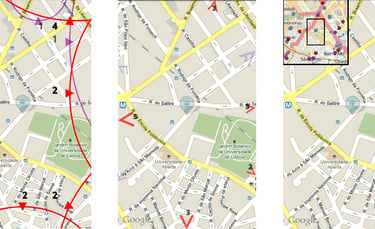

GeoVisualization Research
Context
Between 2010 and 2018 I worked as Junior Researcher, and later as a research Collaborator, at LASIGE, a Computer Science and Engineering research unit at the University of Lisbon. During this period, my research covered the study of the user experience of map-based techniques for:
• the visualization of off-screen information, on mobile devices;
• the analysis of spatio-temporal data, by inexperienced users;
• the self-performance analysis of video game data, by players.
This research resulted in multiple contributions, in the form of scientific papers. Below follows a selected list of those publications.
Publications
(2018) Analysing Player Performance with Animated Maps
Tiago Gonçalves, Pedro Vieira, Ana Paula Afonso, Maria Beatriz Carmo, Tiago Moucho
2018 22nd International Conference Information Visualisation (IV), 103-109
This article presents the results of a user study conducted over a prototype displaying player data from League of Legend's matches. This study had two main goals: (1) to evaluate the usability and usefulness of animation maps for spatio-temporal analysis; (2) identify the analytical strategies employed by users when reviewing their own data.
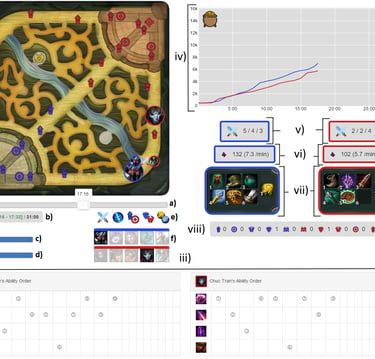

(2016) Why not both? - Combining 2D maps and 3D space-time cubes for human trajectory data visualization
Tiago Gonçalves, Ana Paula Afonso, Bruno Martins
30th International BCS Human Computer Interaction Conference (HCI 2016)
This article presents a user study addressing the adequacy and usability of combining 2D maps and 3D space-time cube visualizations for the analysis of trajectory data. The article focuses on the analysis of quantitative and qualitative results obtained from users interacting with prototypes. The study had the participation of 30 volunteers and, it took into account common objective and subjective metrics (e.g., time, errors and preference ratings), as well as additional efficiency and behavioural information, including % of component use and 3D mitigation strategies.
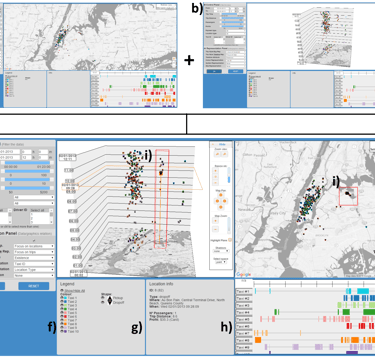

(2015) Cartographic Visualization of Human Trajectory Data: Overview and Analysis
Tiago Gonçalves, Ana Paula Afonso, Bruno Martins
Journal of Location Based Services 9 (2), 138-166
This article presents an overview of the most relevant literature regarding trajectory data visualization focused on three aspects: (1) the main characteristics associated with trajectory data; (2) the most common types of visualization tasks; and (3) the classes of map-based visualization techniques. The article also presents a simplified view over the various types of tasks proposed in the literature, followed by an example study based on said simplification.
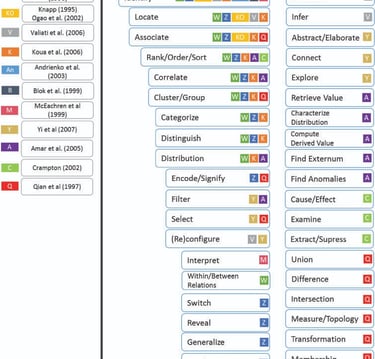

(2015) Improving Spatial Awareness for Human Trajectory Visualization in Space-Time Cubes
Tiago Gonçalves, Ana Paula Afonso, Bruno Martins
IFIP Conference on Human-Computer Interaction - INTERACT 2019, 9299, 327-334
This article presents a user study to assess potential improvements over the space-time cube visualization technique. Three prototypes were compared implementing a baseline version of the technique and two improved ones, through the use of additional maps within the cube or as a two-dimensional overview, respectively. Common quantitative and qualitative usability metrics were analysed, alongside interaction logs including information on behavioral actions, such as nº of interactive actions and 3D mitigation strategies.
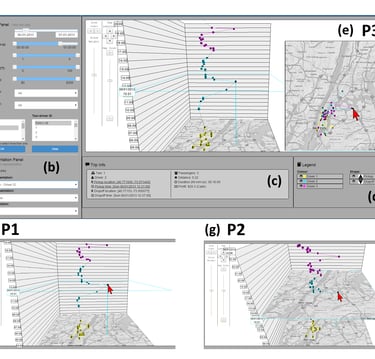

(2014) Visualizing Human Trajectories: Comparing Space-Time Cubes and Static Maps
Tiago Gonçalves, Ana Paula Afonso, Bruno Martins
28th International BCS Human Computer Interaction Conference (HCI 2014), pp. 207-212.
This article presents the results of a user study comparing the usability and usefulness of 2D static maps and 3D space-time cubes for trajectory data visualization. Two prototypes were compared based on the most general types of visualization tasks to be conducted by inexperienced users. The focused on the analysis of user performance and subjective metrics, alongside possible usage patterns through direct observation.
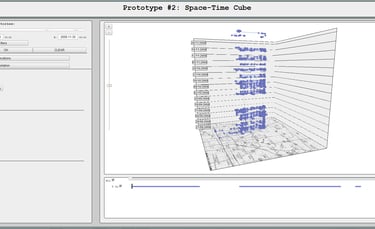

(2013) Comparison of off-screen visualization techniques with representation of relevance on mobile devices
Tiago Gonçalves, Ana Paula Afonso, Maria Beatriz Carmo, Paulo Pombinho
27th International BCS Human Computer Interaction Conference (HCI 2013).
This article presents a comparative user study focused on the visualization of the relevance of off-screen information on mobile devices. Three prototypes were created and compared, based on improved contextual clues, namely HaloDot and Scaled Arrows, and overview+detail techniques, namely a “mini-map”.
